How to get permission and install individual heating in an
Living in apartment buildings with central heating, many complain about cold batteries in apartments. In this case, the bill for heat comes in as if it corresponds to the normal room temperature. It is often not possible to resolve the issue with the supplying organization for the revision of tariffs or payments for the supplied heat energy, since they have their own problems. Only one way remains - to switch to individual heating, as discussed below.
Of course, you can install heating appliances that will save money, however, the temperature in the apartment will not increase from them. In addition, plastic windows and various insulation outside and inside also gives little results. Below you will learn how to make you in an apartment with autonomous heat.
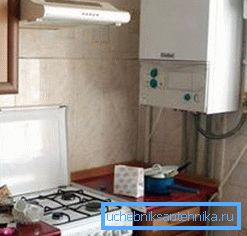
Why autonomous heating is profitable
Heat cost is one of the transition factors.
Another disadvantage of central heating is the high price. Most likely, you have already asked friends who use autonomous heating about their heat costs per month and were very surprised. Indeed, in this case, costs are reduced by 3 or more times, while the apartment has a temperature of 23-25 ° C for the entire heating season, which is most often not possible with DH.

What is this tariff for?
In addition to the cost of heat energy in the prices "sit" and other costs:
- Service, repairs, replacement of heating mains.
- Operation of heavy machinery during excavation of trenches, thermal insulation work, the cost of pipes and other industrial waste.
- Also included are the inevitable loss of heat occurring along the path of the coolant to the consumer. It can often be observed along soaring tracks in the winter. Expensive energy due to improper insulation just goes into the atmosphere, and the vast majority of consumers have to pay for it.
- Maintenance and repair of valves installed in thermal units, the calculation of nozzle diameters in elevators, as well as other inevitable related work.
- Payment for the governing body, accountants, engineers, site managers and ordinary workers must also be paid by the consumer.
If you can install independent heating in the apartment, you will have to pay only for the spent gas. You can, of course, count the installation costs, the permission of the authorities and other expenses here, but after 2-4 years, and maybe faster, since everything depends on the floor space and the cost of heat energy, they will fully justify themselves.
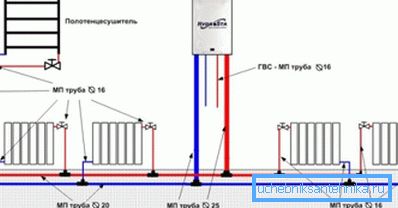
Convenience
Any of us, if he possesses sufficient resources, is willing to pay for comfort. Autonomous heating it fully guarantees. In fact, you yourself determine when to turn it on, and not just from October 15, and when to turn it off, it is possible even later than April 15 (deadlines for the middle country).
The apartment will be set to a temperature that will be comfortable for your family, and not how much heat will come through the main pipelines. Now the plastic windows will not "cry", and on the outer wall will not appear fungus and mold from lack of heating.
In addition, you can now easily control your spending on heat and turn off or lower the temperature if necessary. You must admit that when using the Central Organ it does not give any benefit, everyone will pay the same.
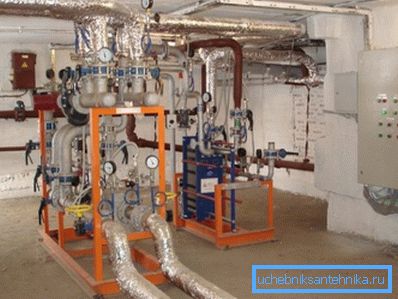
Arguments against
Any system consists of positive and negative qualities.
What disadvantages are fraught with individual heating consider below:
- The high cost of equipment, because of what its payback can be calculated over the years. This applies to the gas boiler, and pipelines, and radiators, and the circulation pump, as well as spending on their installation, if you will not install them with your own hands.
- After disconnection from the central heating station, only risers will remain in the apartment, so you will have to spend time and resources on installing a new heating system circuit.
- We will have to spend money on the installation of a gas boiler and a meter - this is done only by representatives of organizations that have the appropriate license. The instruction allows the boiler only with the burner closed, the air intake is from the street. Otherwise, when the windows are closed, the level of oxygen in the air will quickly fall, and residents are at risk of suffocation.
The cost of the boiler is different and depends on the manufacturer of the equipment, in addition, it can be single or double circuit (hot water is added), which also carries certain expenses.
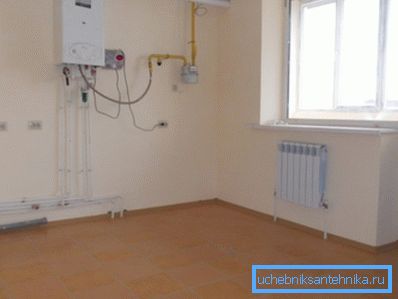
- Removal of combustion products can also be a problem, since the ventilation channel is not always designed to skip a large amount of hot air.
- Neighbors may be indignant when installing a coaxial duct passing through the wall, as the boiler exhaust will inevitably fall on the upper floors.
- Do not forget about fire safety.
- The growth of tariffs for "blue fuel" is also inevitable, since gas is an irreplaceable natural resource.
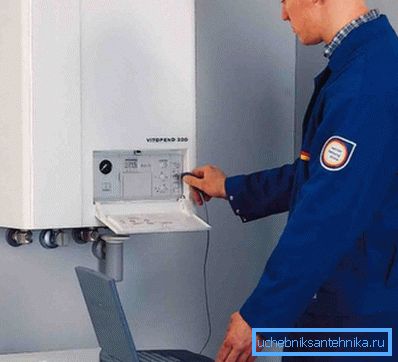
Objections by the authorities
Today, those who decided to install individual heating in the apartment are faced with the refusal of officials. This question is very unpopular and there are reasons for this:
| Economic | In this case, the cash flow to the housing and utilities budget will significantly decrease, which will reduce the income of officials. It will also become a problem financially when the time comes for servicing or repairing worn-out heating systems, because not everyone will be able to install an autonomous system. |
| Technical | When organizing centralized heating, it was taken into account that in all apartments of a multi-storey building there would be approximately the same temperature - the same radiators on the riser, heating of the coolant is almost the same. When installing autonomous heating, the following theoretically can occur a few degrees, will begin the flow of heat through the walls and floors from neighboring apartments. Thereby, you will start using it illegally, and your neighbors will become colder. In practice, everything is exactly the opposite. And what happens when you leave, and the apartment remains without heating? Heat consumption will increase, since it will also have to be heated, which may in the future lead to freezing of internal partitions and defrosting the water supply. |
Installation of individual heating
If you have decided to disconnect from the Central Organ, there will be no surprises from the autonomous system. Distribution and connection of radiators will be exactly the same as when creating heating in a private house.
Tip: if you doubt your knowledge and skills, it is better to contact a professional plumber.
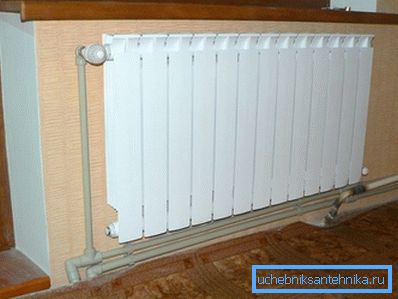
When choosing circulation there are only two options - natural and forced. When you have chosen a wall boiler, you can forget about the first method, since the heat source will be located above the heaters, so you cannot create a normal movement of the coolant. The good news is that in modern household wall-mounted boilers, the circulating pump is located in its housing, so this will facilitate the connection of the system.
Radiators
In the autonomous heating system, in contrast to the central one, the parameters of the coolant are always stable. The temperature and pressure do not exceed the specified values, therefore no water hammer occurs.
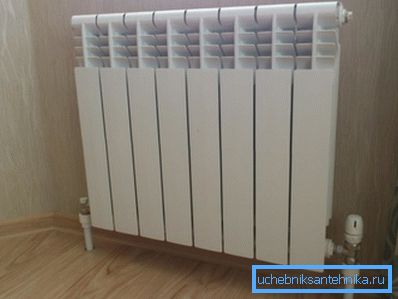
In this case, the best option is aluminum batteries. They have a beautiful appearance, their price is low, and the heat output per section is 2 times higher than the cast-iron analogs.
Tip: You can also consider installing in the apartment water heated floor, which requires a small temperature in the boiler.
Although in this case you need to pay attention to the height of the ceilings, so that they "do not crush" after the repair. In addition, the alteration itself will require global transformations.
Pipeline
In our case, the parameters are stable, and the pressure is small, so it is better to stay on the plastic. Its cost is much cheaper than steel pipes, besides, you can connect them with an inexpensive special soldering iron with your own hands.
It remains only to choose from:
- Reinforced polypropylene pipes for heating, which will be the cheapest option and will require a minimum set of tools and some skills for installation. Reinforcement mainly reduces thermal expansion of the liner and bottling.

- Cross-linked polyethylene, which will cost not only a bit more expensive, but also an expensive extender tool is needed to work with it. As a result, we get a more durable system and more resistance to pressure and temperature, although this is not the decisive factor.
Distributing pipes in the apartment
The cheapest option is considered "Leningrad" or one-pipe system, but if you have the opportunity to install it around the perimeter of the room. In this case, the radiators crash into the heating circuit in parallel and do not break it.
Tip: for adjusting the temperature in each battery, you can independently use a bypass circuit.
The inconvenience in this case is to stroke the entrance and balcony doors from above or below. But the two-pipe wiring will make it possible to make only 2 independent semi-circuits with 2 sides from one of the doors, since the second one will also have to be circled.

From the point of view of convenience and aesthetics, we recommend the collector connection scheme of radiators, which is also called the radial one. In this case, each heating appliance will be suited to its own eyeliner, usually laid on the floor. In this case, you also need to pre-calculate the height of the ceiling, which is obtained after performing the screed.
Tip: if the apartment has a wooden plank floor, radial layout can be laid between the logs, which will require partial disassembly of the coating.
Legal part
From the foregoing it is clear that installing an autonomous system in an apartment is not difficult. Therefore, it is necessary to solve the main problem - bureaucratic. And here, many are rejected by officials who refer to Federal Law No. 190 “On Heat Supply,” where they allegedly say that it is prohibited to switch to individual heating in an apartment building. You should not despair, but you need to consider the question in more detail.
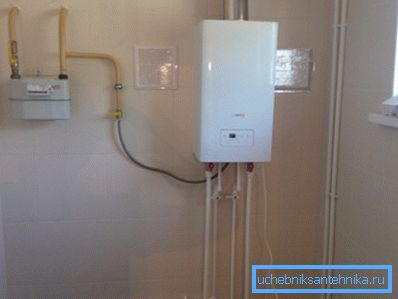
So far, there is a misinterpretation by many of the current legislation. In fact, the law does not prohibit, but only specifies the types of boilers that can be installed. For which it is necessary to read the Resolution of the Government of the Russian Federation No. 307 of April 16, 12, namely paragraph 44.
It states that it is prohibited to install sources of heat energy for the operation of which natural gas is used, in which:
- no closed combustion chamber;
- there is no safety automatic, which stops the supply of fuel when:
- no electricity;
- defective protection circuits;
- extinguishing the burner flame;
- the coolant pressure drops below the permissible limit;
- achievement of the maximum allowable temperature by the coolant;
- violation of smoke removal;
- the heat carrier can heat up above 95 ?;
- coolant pressure exceeds 1 MPa.

From this it follows that under the current legislation, the transition to autonomous heating is allowed using modern heating boilers that meet the above requirements. The judicial practice of courts of general jurisdiction on this issue shows that the refusal of the local government on the basis of paragraph 15 of Art. 14 of the Federal Law "On Heat Supply" in the re-equipment of the heating system, is not recognized in the courts and is canceled.
Conclusion
Converting an apartment to independent heating is not only possible, but also beneficial, since at the same time the cost of heat will be limited only to the cost of gas. Initial costs can be large, but they can really save, if the installation of the heating system is done independently.
When choosing a boiler, it is necessary to proceed from the requirements of the legislation. The video in the article will provide an opportunity to find additional information on this topic.